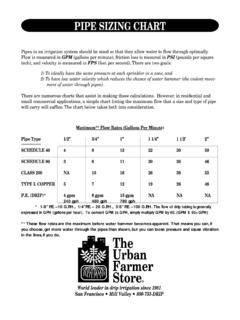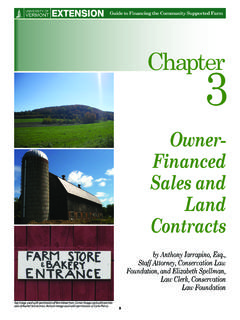Transcription of The Urban Farmer Store’ Wiring Guide for Low …
1 Price and availability subject to change without noticeThe Urban Farmer Store s Wiring Guide for Low Voltage Systems Lighting Cable comes in several sizes or gauges. Twelve, ten, or eight gauge cable tends to be the most commonly used, depending on the lengthof the wire run and the wattage load. Choosing the correct size of cable is necessary to avoid excessive voltage drop, which leads to the dimming oflamps at the end of wire runs. You can use smaller, less costly 14, 16, and 18 gauge cable for LED systems. Use thevoltage drop calculater on our Cut the main run of laying out wire, leave aone foot diameter loop whereeach fixture will Gauge Lighting Cable312x212 gauge per gauge 250 $ gauge 500 $ Gauge Lighting Cable310x210 gauge per ft $ gauge 250 $ gauge 500 $ Gauge Lighting Cable38x28 gauge per ft$ gauge 250 $ actual size, (l to r) 12 gauge, 10 gauge and 8 gauge.
2 Low voltage lighting cable is UV resistant and suitable fordir ect burial. It is often easier to use two runs of 12 or 10 gauge than deal with the huge girth of 8 gauge to splice a light into a run of outdoor lighting cable. You will need wire cutters/strippers, two appropriately sized wire nuts, andone cable tie for each fixture. 2. Strip the end of each wire, sothat 3/4 of bare copper Place one wire from eachmain run with one wire from thefixture. Repeat with other Tur n wire nut on to the groupof wires until it stops with other Bundle all wires together anduse a cable tie or electrical tapeto secure them points and typical layout methods for lighting. We recommend using the hub method wherever possible. Use other methods so longas you test with a volt meter at each test point for voltage between to 12 volts.
3 Multi-taps on transformer can also help correct for voltage to specify the right cable Voltage drop iscr eated by internal resistance to the flow of electricitythrough electrical cable. It is the difference between thevoltage at the beginning (transformer or source) of acable run and that at its end. If the voltage drop is greatenough, there will be a noticeable decrease in lampbrightness along the cable. The maximum acceptablevoltage drop is to volts. Use the formuladescribed below to determine voltage drop and to correctfor it by using the appropriate kind of lighting the length of the wire run in feet by the totalwattage on that run. Divide the result by the selectedcable size constant. This will give you the amount ofvoltage drop for fixtures more or less evenly distributedalong the run.
4 This figure may need to be adjusted,depending on fixture for fixture placement If 60% or more of the fixtures are in the first half ofthe run, reduce the voltage drop figure by 25% (multiplyvoltage drop result by .75). If 60% or more of the fixtures are in the last half of therun, increase the voltage drop figure by 25% (multiplyvoltage drop result by ). If 100% of the fixtures are on the last half of the run,multiply voltage drop result by 2. If this adjusted voltage drop is greater than , thencontinue recalculating for the next size larger cable(smaller gauge #) constant until the voltage loss value isless than Use the cable size for the constant thatproduced the desired result, and use a higher or lowervoltage tap, if provided on the Drop FormulaLength of run in feet_____X (multiply)Number of watts on run_____Total=_____ (divide)cable size constant_____=Voltage drop_____Cable size constants12 gauge750010 gauge119208 gauge18960 Maximum allowable voltage drop is MethodTest PointTransformerTest PointTransformerHub MethodTee MethodTest PointTransformerSeries MethodTest PointTransformerRecomm







